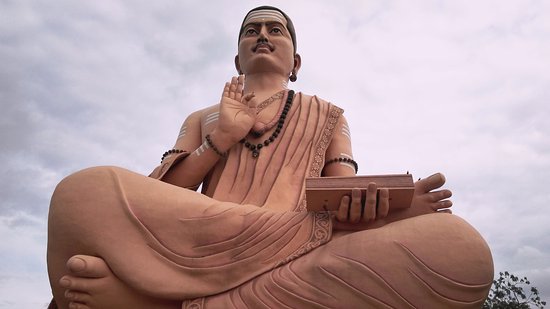
To Lingayats, Congratulations on Freedom from the Vedic Religion
There were very few movements in India which openly defied rules of caste and Vedas. One of such movement was Lingayat movement, founded by Basavanna in northern Karnataka in the 12th century. Lingayatism emerged as a reactionary force against Brahminism. Lingayat rejects Vedas and cruel Hindu caste system. According to Lingayat religion, they don’t believe in Vedas, Bhagavad Gita, Purana or Upanishads, neither they worship 33 crore Hindu Gods or bow to Brahmins. They also don’t believe in caste, rebirth or karm-kand etc.
Basavanna was from Brahmin class and a minister in the kingdom of Kalyana but he rejected Vedas, sacred thread and priestly rituals, which set Lingayatism separate from Brahminism. There were no temples instead there were free discussion areas, where men and women both could perform priestly functions. Another aspect that set Lingayatism apart from Brahminism is women could perform priestly functions. When rules of Manusmriti and Vedas kept women on the sideline, Lingayats gave equal rights of worship or preaching religion to all men and women without discrimination. Thousands of women were part of the world’s first democratic parliament Anubhava Mantapa during the 12th century.
Basavanna’s vision of a societal order was based on human freedom, equality, rationality, and brotherhood, all these aspects are missing in Brahminism. In one of his sermon, Basavanna asserts that
“the birthless has no caste distinctions, no ritual pollution.”
Gail Omvedt in her book ‘Understanding Caste, From Buddha to Ambedkar and Beyond‘ writes, in the 12th century, when it was unthinkable, Basavanna sponsored a marriage between the son of a Dalit member and the daughter of a Brahmin. Even though he was a minister in the kingdom, this was too much. The parents were brutally executed; the result was a near civil war in the kingdom and Lingayats were driven out. Few bhakti movements after that openly – at least – broke the firm caste law of the prohibition of varna-samkara.
All those who are claiming that recognizing Lingayat as a separate religion is a dangerous attempt to divide Hindus, they should keep in mind that Indian society is already divided into thousands of castes and sub-castes. Recognizing Lingayats is not a division of any religion, but a recognition of a set of people who follow certain path and principles, which are entirely different from any other religion.
There are almost 6 million Lingayats and forms almost 17 percent of Karnataka’s population hence the move to recognize Lingayats as a minority and separate religion definitely would bring cries about vote bank politics but it’s a time to accept that Lingayats were different from Brahminism hence should be recognized accordingly.




How many of those 6 million lingayats want a separate religion and don’t think themselves as a Hindu? I have seen on social media many lingayats not really are inspired by the theory you have mentioned above.
Veerashaiva and Lingayat are different. Veerashaivas are part of the Shaiva, Vaishnava tradition of `Hindu’ (Brahminical) religion. Lingayat is a religion which protested against the Shaiva, Vaishnava traditions of the Brahminical `Hindu’ religion and emerged as a new religion. Lingayat religion, inspired by not just Basavanna, but all the vachanakaras of the 12th century, is a separate religion which has no connection with Brahminical Hinduism or its off=shoots like Veerashaivas. These are the differences between Brahminical Hinduism/ Veerashavism and Lingayat dharma
1. Lingayat dharma does not believe in temples. Basavanna said in one of his famous vachanas that the body is the temple and the soul (conscience) is god. (Hence, for Lingayats to support a temple in the name of Rama (who is supposedly an avatar of Brahminical Hindu dharma Vishnu= Vaishnava) is against Lingayat dharma. Anyone who supports the RSS/BJP/ other Sangh inspired Ram Mandir movement is going against the tenets of Basavanna and Lingayat dharma.
2. Lingayat dharma does not believe in idol worship. Lingayat dharma only supports the worship of the `Ishta Linga’ , which is a representation of inner conscience and social responsibility (It does not represent any god. It most certainly not represent Shiva. Basavanna only said `Koodalasangama deva’ which leaves itself open to innumerable interpretations, but MOST definitely not as an invocation for Shiva- a Brahminical idol). So, anyone who worships idols is betraying the cause of Basavanna and the Lingayat dharma.
3. Basavanna had opposed fire worship such as homas and havanas. Which means that any Lingayat who performs homas and havanas is anti-Lingayat dharma. (Yeddyurappa has performed many homas and havanas. Hence, he is not really a Lingayat: he does not follow the tenets of Lingayat dharma. In fact, Yeddyurappa is anti Lingayat dharma.
4. Lingayats are not fire worshipers. They do not believe – as Brahminical castes and Veerashaivas do- that fire purifies. That is why in Lingayat marriage and death ceremonies, fire does not find a place. One more point: Lingayats are perhaps the only `supposed Hindus’ who still bury their dead. Because Lingayat dharma believes in its followers becoming part of the earth that gave birth to them and sustained them in their lives so that by becoming part of the earth they shall sustain new life: like being manure to new crops which will feed the next generation. Lingayat dharma does not believe in burning its dead. Those who burn their dead are only polluting our lakes and rivers. Lingayat dharma which opposes such pollution is environmentally friendly.
5: Lingayat dharma stands for equality. It does not discriminate against class or caste. It is the most egalitarian religion to have been born in the 12th century in this country.